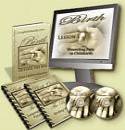How Painful is Childbirth?
How painful is childbirth? While this is a common question of expectant mothers, the answer is shocking to most: Only as painful as you make it. While this may seem radical, most pain in childbirth is created from external sources and is completely unnecessary and preventable. Sadly, the majority of pregnant women have no idea this is true.
There are three main factors that create discomfort in childbirth. These factors are separate yet the interaction between them can lead to an overall unpleasant birthing experience.
Anxiety
When a mother asks "how painful is childbirth", it is already apparent that the question is causing her to experience anxiety, or fear of the unknown, which is the leading cause of discomfort in labor. When ladies giving birth are anxious, the body's normal response to stress, which is to send more blood and oxygen to the major organs and away from the extremities, is triggered. For the labouring woman, this means that blood and oxygen are diverted from her uterus and her baby, both of which can lead to birth complications, such as decreased fetal heart rate or increased discomfort for the mother. If the cycle continues unchecked, the mother may eventually require more and more interventions which increase risks to herself and her child.
For these reasons, mastering relaxation techniques is critical for all natural births. They are simple, highly-effective methods that alone can significantly decrease or even eliminate discomfort in labor. Relaxation is the basis of a comfortable birth for all women. For detailed information on relaxation for birth, please refer to the Relaxation Techniques section.
Body Positioning
Poor positioning, which leads to ineffective or excessive muscular effort, is one of these easiest sources of discomfort to eliminate in labor and birth. As discussed in Relaxation Techniques, body-wide tension or unnecessary muscular effort can cause discomfort and fatigue. Ladies giving birth who are tense fatigue easily and find birthing more difficult because they are tensing muscles that should be relaxed.
Physical Sources
This type of discomfort can arise from the stretching and reshaping of the body during labour. The tissues of the perineum must be allowed to stretch to decrease the risk of tearing. Women often speak of a "ring of fire" as the baby's head crowns. However, this can be eliminated by performing perineal massage throughout the latter weeks of pregnancy, as outlined in the Preparing for Birth section. Additionally, appropriate exercise during pregnancy will allow the body to be more flexible and better adapt to the changes needed for birthing.
Inadequate Nutrition
While many hospitals forbid eating or drinking during labor, a woman can quickly become dehydrated, especially in a long labor. When the body becomes dehydrated, all bodily functions suffer. Muscles must work even harder to accomplish the same tasks. Muscular efficiency can drop by as much as 30%. In response to current research findings, in 2009, ACOG revised its position on hydration during labor, recommending that women be allowed clear fluids as desired.
Without enough energy, women may tire quickly and be less able to remain comfortable throughout labor. However, as many hospitals have not yet aligned their policies to reflect the current research and still restrict food or drink during labor, an easy solution is to stay home as long as possible. If planning a homebirth, have light snacks, juice or sports beverages readily available.
Many women don't feel hungry or will even vomit during active labor or transition. But for those that do feel the desire to eat, lighter is better. A good rule of thumb is that if your body tells you to eat, then eat.
By first addressing and removing these three unnecessary, preventable sources of discomfort, women can face the question of "how painful is childbirth" with more perspective on how to address the underlying anxiety it reveals.
References
Anim-Somuah M, Smyth R, Howell C. Epidural versus non-epidural or no analgesia in labour. Cochrane Database of Systematic Reviews 2005, Issue 4. Art. No.: CD000331. DOI: 10.1002/14651858.CD000331.pub2.Cluett E R, Nikodem VC, McCandlish RE, Burns EE. Immersion in water in pregnancy, labour and birth. Cochrane Database of Systematic Reviews 2002, Issue 2. Art. No.: CD000111. DOI: 10.1002/14651858.CD000111.pub2.
Hodnett ED, Gates S, Hofmeyr GJ, Sakala C. Continuous support for women during childbirth. Cochrane Database of Systematic Reviews 2007, Issue 3. Art. No.: CD003766. DOI: 10.1002/14651858.CD003766.pub2.
Smith CA, Collins CT, Cyna AM, Crowther CA. Complementary and alternative therapies for pain management in labour. Cochrane Database of Systematic Reviews 2006, Issue 4. Art. No.: CD003521. DOI: 10.1002/14651858.CD003521.pub2.
Gupta JK, Hofmeyr GJ, Smyth R. Position in the second stage of labour for women without epidural anaesthesia. Cochrane Database of Systematic Reviews 2004, Issue 1. Art. No.: CD002006. DOI: 10.1002/14651858.CD002006.pub2.
Return from How Painful is Childbirth to Labor Pain Management
Return to Giving Birth Naturally Home
Page Last Modified by Catherine Beier, MS, CBE
Most Popular
How to Use Acupressure to Induce Labor
Childbirth Relaxation Script MP3s
Nutrition During Pregnancy - Nix the Notion of Eating for Two
Looking for a Birth Professional? Search our Provider Directory
Online Childbirth Classes
Choose 7 week, 12 week, or Self- Paced online childbirth classes available wherever and whenever you need them.
Featured Birth Story
Vanessa's natural birth story shows that when birth is left alone to proceed as it should, it waits for no one - not even doctors or midwives.
Free Pregnancy Tickers
Create a free pregnancy ticker to post on your blog, website, Facebook profile or favorite social media...




